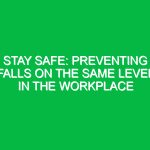Introduction
In the realm of Health, Safety, and Environment (HSE), the 3 points of contact rule stands as a fundamental principle aimed at enhancing Safety while working at heights or on ladders, machinery, and other elevated surfaces. This rule emphasizes maintaining three points of contact with a stable structure at all times, significantly reducing the risk of falls and accidents. In an industry where Safety cannot be compromised, understanding and mastering this rule is crucial for every worker.
The importance of the 3 points of contact rule cannot be overstated. It not only serves as a practical guideline for safe movement but also embodies the broader commitment to minimizing risks in various work environments. By ensuring that individuals maintain three points of contact, the chances of slips, trips, and falls—leading causes of workplace injuries—are drastically reduced. This article delves into the key aspects of the 3 points of contact rule, exploring its significance, implementation, associated risks, and Best Practices for fostering a safe working environment.
Understanding the 3 Points of Contact Rule
What Does the 3 Points of Contact Rule Mean?
The 3 points of contact rule refers to the practice of ensuring that at least three parts of the body are in contact with a stable surface while ascending or descending a ladder or any elevated platform. Typically, this includes two hands and one foot—or two feet and one hand. The core premise is to provide maximum stability and support, thus minimizing the risk of falling.
This rule is vital not only for those working in construction but also for anyone involved in Maintenance, warehousing, or even in office settings where ladders and elevated equipment are used. The simplicity of the rule belies its importance; it is a straightforward yet effective method to promote safety.
Key Components of the 3 Points of Contact Rule
To effectively implement the 3 points of contact rule, one must consider several key components:
- Awareness: Understanding the environment and being conscious of potential Hazards.
- Proper Technique: Learning the correct methods for climbing and descending.
- Use of Equipment: Ensuring that ladders and platforms are in good condition and suitable for the task.
Each component plays a crucial role in ensuring the effectiveness of the 3 points of contact rule.
The Importance of the 3 Points of Contact Rule in HSE
Reducing Fall Risks
Falls are one of the leading causes of workplace injuries and fatalities. The 3 points of contact rule directly addresses this issue by providing a stable base for the worker. By maintaining three points of contact, the body’s center of gravity is better balanced, reducing the likelihood of losing footing. A study by the Occupational Safety and Health Administration (OSHA) found that implementing such Safety Measures can lead to a significant decrease in fall-related injuries.
Enhancing Worker Confidence
When workers understand and apply the 3 points of contact rule, their confidence in navigating heights increases. This psychological benefit cannot be underestimated; when workers feel secure, they are less likely to rush or take unnecessary risks, further enhancing safety.
Promoting a Safety Culture
Incorporating the 3 points of contact rule into daily operations fosters a culture of safety within organizations. When safety protocols are consistently followed and reinforced, it cultivates an environment where workers prioritize their well-being and that of their colleagues. This cultural shift is essential for long-term compliance with HSE practices.
Best Practices for Implementing the 3 Points of Contact Rule
Proper Training
One of the most effective ways to ensure that the 3 points of contact rule is adhered to is through comprehensive training programs. Workers should be educated not only on the mechanics of the rule but also on its importance. Interactive workshops, simulations, and hands-on training can reinforce these concepts effectively.
Regular Equipment Inspection
Before using ladders or elevated platforms, it is crucial to conduct regular inspections. Ensuring that equipment is in good condition and free from defects can prevent accidents. Workers should be trained to recognize the signs of wear and tear and to report any issues immediately.
Safe Climbing Techniques
When climbing a ladder or elevated surface, there are specific techniques that should be followed to maximize safety:
- Maintain Three Points of Contact: Always have two hands and one foot, or two feet and one hand on the ladder.
- Face the Ladder: Keep your body facing the ladder while climbing or descending.
- Keep Tools Secure: Use a tool belt or hoist tools to avoid the need for one-handed climbing.
Mastering these techniques can significantly reduce the risk of falling, ensuring that safety remains a priority.
Potential Hazards and Safety Considerations
While the 3 points of contact rule is designed to enhance safety, there are still potential hazards that workers must be aware of.
Environmental Factors
Weather conditions can greatly affect the safety of working at heights. Rain, snow, or even strong winds can create slippery surfaces or destabilize ladders. Workers should always assess the weather before beginning any task that requires elevation.
Worker Fatigue
Fatigue can impair judgment and physical capability. When workers are tired, they may be more likely to neglect safety protocols, including the 3 points of contact rule. Encouraging regular breaks and monitoring workload can help mitigate this risk.
Regulations and Standards
In many countries, adherence to the 3 points of contact rule is not just a best practice; it is also a regulatory requirement. Various organizations, including osha in the United States, have established guidelines that outline the proper use of ladders and working at heights.
These Regulations typically include:
- Requirements for ladder design and maintenance
- Training requirements for employees
- Protocols for inspecting equipment
Understanding these regulations is crucial for compliance and to ensure a safe working environment.
Conclusion
Mastering the 3 points of contact rule is essential for anyone working in environments where falls are a risk. This simple yet effective safety measure significantly reduces the likelihood of accidents and injuries, fostering a culture of safety that Benefits everyone involved.
As workplaces continue to evolve, the need for robust Safety Measures like the 3 points of contact rule remains paramount. It is not just about following rules; it is about creating a mindset where safety is prioritized at all levels. By engaging in proper training, regular equipment inspections, and a commitment to Safe Practices, workers can navigate their environments confidently and securely.
In closing, the 3 points of contact rule is a testament to the commitment to health, safety, and environmental integrity. Let this serve as a reminder to always be vigilant and proactive about safety, ensuring that we protect not only ourselves but also our colleagues and the environment we work in.


